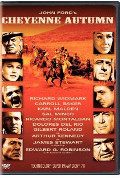
Directed by
John Ford
159 minutes
Rated PG
Reviewed by
Bernard Hemingway

Cheyenne Autumn
Although suffering from many of the problems of the bloated Hollywood productions of the early 60s Ford’s last Western, has its virtues. For a start, Ford substantially addresses the white man’s shameful treatment of the land’s original inhabitants, something which he had only alluded to or largely accepted as a given in his previous films. He also revises his position on compliance with authority – most infamously stated in Fort Apache.
These ideological shifts give the film interest, at least for those familiar with the director’s earlier work, but aside from this Cheyenne Autumn, is a visually striking film – shot in Ford's favourite location, Monument Valley, with William Clothier’s camera making good use of the Super Panavision 70 format with many slow widescreen pans and choreographed big action scenes.
Based on an actual event in 1878 when a small tribe of Northern Cheyenne Indians tried to return to their homeland 1,500 miles away in the Yellowstone River country from a barren area in Oklahoma to which they had been transported and abandoned by Congress, their story is told by Captain Archer (Richard Widmark) a cavalry man assigned to capture and return them to their reservation, a task for which he has no stomach .
Ford tackles the story with compassion and grand ambition but the film, which apparently endured much studio interference, has as many problems as virtues. As is typical of the time it assumes an epic style complete with an overture and entr’acte and a top heavy score by Alex North and if the main story is not protracted enough there is also a strangely irrelevant semi-comic interlude about halfway through the film in which James Stewart and Arthur Kennedy appear as the most unlikely Wyatt Earp and Doc Holliday. This is immediately followed by an intermission, never a good idea, and the film is unable to recover its tonal integrity thereafter.
Whilst the treatment of the Indians is bold for its time, in its use of Cheyenne language well anticipating Dances With Wolves in this respect, the use of European cast members (including Sal Mineo, Delores De Rio, Gilbert Roland and Ricardo Montalban) seriously undermines its authenticity and Ford does not really advance beyond cigar store concept of noble savage. In addition although Ford’s visual style is immediately recognizable the dramatic style is generically of a piece with the heavy-hand approach of tent pole productions of the time. In this respect there is little difference between the flight of the Cheyenne and that of the Israelites in The Ten Commandments even down to some really awful back projection when Edward G. Robertson,who was too ill to travel, supposedly visits the beleaguered Cheyenne to reassure them of the Government’s credibility
Widmark and Mike Mazurki are no substitute for John Wayne and Victor McLaglen and there is a rather insipid sub-plot involving a romance between Captain Archer and a pretty Quaker schoolteacher (Carroll Baker) who accompanies the Indians on their desperate homeward trek, a character apparently forced on Ford by the Warners.
Cheyenne Autumn is certainly a significant film in the Ford canon but it also certainly lacks the integrity of his famous cavalry trilogy.
Want something different?





